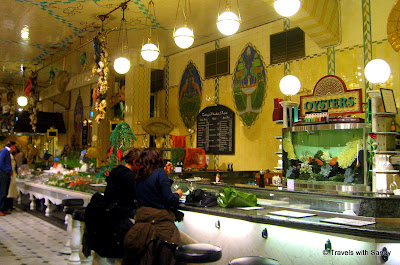Since my mother-in-law is an architectural historian specializing in churches, we decided to take another bus tour in order to see Canterbury Cathedral. If you have been following this series on London, you may have noticed that our sightseeing has been slanted toward history and architecture for this trip. This is part of the reason why we did more tours than usual. We were also interested in seeing some more castles and the Cliffs of Dover, so we decided to take a tour that visited Leeds Castle, Canterbury Cathedral, and Dover. These three sights are often grouped together for touring purposes because they are all located to the east of London.

Leeds Castle
Our first stop was Leeds Castle, a lovely castle in Kent. While not a major castle, Leeds has a history as a royal residence and is a fine example of a moated castle. The castle grounds include a museum and several gardens, an aviary, dog collar museum, maze, conference center and other attractions. You can even have a wedding here!

The grounds of Leeds Castle were graced with Black Swans.
Although a manor stood there before the Norman conquest, the first stone fortifications date back to the 1100s.

Ruined parts of the older fortification at Leeds Castle.
Edward I and his queen Eleanor of Castille lived there in the 1200s, making it a royal palace. From that point forward, royalty occasionally resided there, including several queens. The castle was often used as a stopover for trips to and from the Continent, including a famous visit by Henry VIII before his meeting with Francis I in France in 1520. You can read more of the history of the castle here.

Leeds Castle

After the middle ages, the castle eventually passed into the hands of private owners and was purchased by the Culpeper family. The Hon. Olive, Lady Baillie, the last private owner of Leeds Castle remodeled the castle into a gracious home and created a private foundation for the maintenance of the castle. Today, the foundation owns and operates the castle.

Leeds Castle
Inside the museum, there are guides in every room. You can ask them any questions you would like. I found the medieval parts of the castle much more interesting than the remodeled gracious home sections.



I did appreciate this sun filled library, though.

The maze was interesting as a novelty. Since I had never been inside a hedge maze, I had to go in and see. We met one of the other people in our tour group at the entrance to the maze. Apparently, he had been stuck in the maze for 25 minutes! Fortunately, a kindly tourguide offered to lead us through the maze since we were short on time and needed to get back to the bus. At the center of the maze is a cheesy “grotto” with some lit up monsters and mermaids.

While historically Leeds was a relatively minor royal castle, we still enjoyed our visit here. The castle and grounds are beautifully kept and maintained, the guides welcoming and informative, and it was lovely to just stroll around and enjoy the romantic environs. I could definitely see myself living here. Oops, did I say that out loud?

After Leeds Castle and a brief forgettable lunch, we drove to the city of Canterbury to view its famous Cathedral. As the cathedral of the Archbishop of Canterbury, leader of the Church of England, this structure is the most important cathedral in all of Britain.

Entrance to Canterbury Cathedral
Canterbury Cathedral is also famous for being the site of the martyrdom of Thomas Becket and the pilgrims who visited his shrine as told in Chaucer’s Canterbury Tales.

The site of the martyrdom of Beckett.
Outside of its historical and religious significance, the cathedral itself is magnificent. Canterbury Cathedral was founded in 602 AD by St. Augustine and dedicated to St. Savior. Over the centuries, successive archbishops extended and added onto the main structure. Fires and raids also prompted new designs through the centuries.


The cathedral has both Norman and Gothic architectural styles incorporated within its design.

The nave at Canterbury Cathedral

The ceiling at Canterburgy Cathedral

View of the choir at Canterbury Cathedral
Personally, I found the Norman crypt the most beautiful and intriguing part of the tour, but pictures are not allowed. Down below ground, the crypt was dark, quiet, and very still. There are small chapels within the crypt where you can see faded paintings on the walls that date back a thousand years. It was truly a humbling experience.
Our final destination on the tour was the town of Dover, home of the famous White Cliffs of Dover. Dover is geographically the closest part of England to France, and located just across the Channel from Calais.

View of the seashore in Dover

The White Cliffs of Dover

Dover Castle
We viewed Dover just as the sun started to go down. It was a peaceful way to end our day.

















































Recent Comments